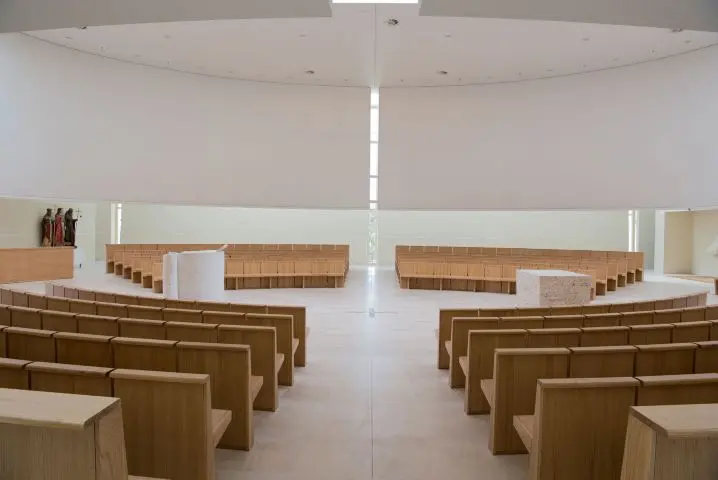卡斯泰尔迪拉马的教堂和社区中心

下载所需积分: 2
这座教堂是由studio_continiarchitettura设计的教区中心中最后建成的建筑。该综合体包括体育和休闲设施、教育空间和会议场所,形成一个促进社区生活的城市系统。该项目源于2006年举行的竞赛,深深扎根于其环境中,无论是通过体量的布局还是使用当地材料。
与周围环境的关系通过穿过广场的步行道得到了进一步增强,该步行道延伸至大型方形花园。这个空间南侧被一面简单的墙壁围绕,朝向主干道则有一个封闭的走廊。这些界限创造了一种聚集感,形成一个适合社区生活和集体会议的空间。项目的一个基本元素是穿过综合体的公共步行道,将教堂与教区活动的建筑体分开,并暗示与周围公共区域的可能城市连接。钟楼位于主街和居民区的方向,凭借其高度向周围地区指示教区中心的位置。教堂的外部以石灰华板材的立面为特征,形成一个过滤器,让人们能够窥见建筑内部。
内部设有一个大型悬挂的椭圆形天篷,作为集会和礼仪的空间。礼仪所需的元素 “洗礼池、讲台、祭坛、座椅、十字架和圣体匣” 沿着一条纵向切割圣坛的路径布置,通向教堂后方的一个花园,花园中种植了一棵橄榄树。
集会的布置遵循第二次梵蒂冈大公会议的指示,圣坛被信徒的座位环绕,形成教会的本质。讲台和祭坛位于椭圆的焦点上,面对面设置,强调了圣体和圣言的平等尊严。
朱利亚诺·朱利安尼创作的宏伟石灰华艺术品被安置在教堂内部,精神上定义了礼仪的场所。
The church is the last building, in order of construction, of the parish centre designed by studio_continiarchitettura. The complex includes sporting and recreational facilities, spaces for education and meeting places, creating an urban system that promotes community life. The project, developed from a competition held in 2006, is deeply rooted in its context, both through the disposition of its volumes and the use of local materials.
The relations with the surrounding settlement are further enhanced by the pedestrian path that passes through the parvis, which extends in the large square garden. This space is bordered by a simple wall on the southern side and by a closed portico towards the main road. Those limits create a sense of gathering, a space that suits the needs of community life and collective meetings. A fundamental element of the project is the public pedestrian path that cuts through the complex, separating the church from the volumes for the parish activities and suggesting possible urban connections with the surrounding public areas. The bell tower, placed towards the main street and the settlement, indicates the position of the parish centre to the surrounding area, thanks to its height. The exterior of the church is characterised by its façade in slabs of travertine forming a filter that allows glimpsing inside the building.
The interior accommodates a large suspended elliptical velarium, place for the assembly and space for the liturgy. The elements for the liturgy (baptismal font, ambo, altar, seat, crucifix and tabernacle) are placed along a path that cuts the chancel longitudinally and reaches a garden on the back of the church, in which an olive tree is planted.
The assembly dispositions follows the dictates of the Second Vatican Council, with the chancel surrounded by the seats for the believers, forming the essence of the Church. The ambo and the altar are placed on the foci of the ellipse, facing each other, emphasizing the equal dignity of the Eucharist and of the Word.
The magnificent artworks in travertine by Giuliano Giuliani, placed inside the church, spiritually define the places of the liturgy.